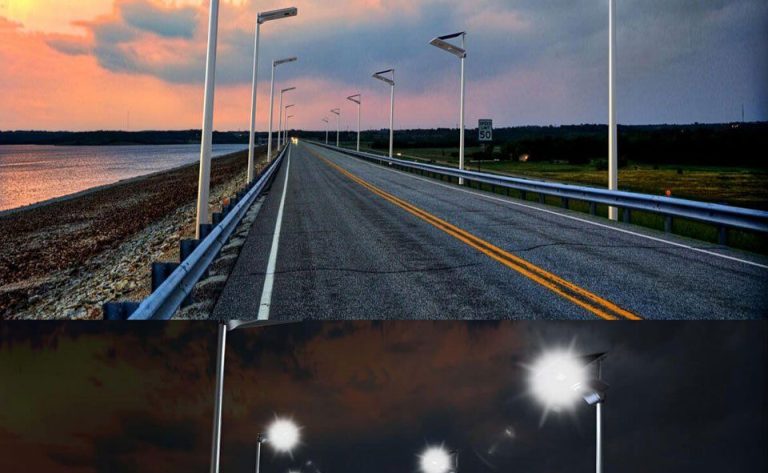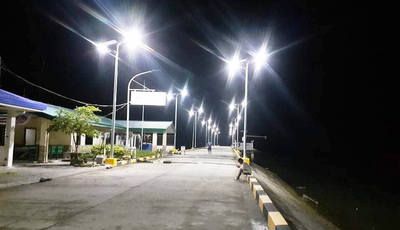Table of Contents
Understanding the Cost Components of All-in-Two Solar Street Lighting Fixtures
All-in-Two solar street lighting fixtures have emerged as a sustainable and cost-effective solution for illuminating streets and public spaces. As communities increasingly turn to renewable energy sources to meet their lighting needs, understanding the cost components of these fixtures becomes crucial. In this article, we will delve into the various factors that contribute to the cost of All-in-Two solar street lighting fixtures, and explore why wholesalers play a significant role in the procurement process.
Firstly, the primary cost component of All-in-Two solar street lighting fixtures lies in the quality and efficiency of the solar panels and batteries used. High-quality solar panels with advanced photovoltaic technology can capture more sunlight and convert it into electricity efficiently. Similarly, reliable batteries with a long lifespan ensure uninterrupted power supply during nights or cloudy days. Consequently, the initial investment in superior solar panels and batteries may result in higher upfront costs but leads to long-term savings through reduced maintenance and replacement expenses.
Moreover, the design and engineering of All-in-Two solar street lighting fixtures influence their cost. Innovative designs that incorporate features such as adjustable solar panels, intelligent energy management systems, and durable materials contribute to higher initial costs but offer enhanced performance and durability over time. Engineering intricacies such as weatherproofing and resistance to environmental factors ensure reliable operation in various climatic conditions, further justifying the investment in premium fixtures.
Additionally, installation and maintenance expenses constitute significant cost considerations for All-in-Two solar street lighting fixtures. Proper installation by trained professionals ensures optimal positioning for maximum sunlight exposure and efficient operation. Furthermore, routine maintenance activities such as cleaning solar panels, inspecting electrical connections, and replacing faulty components are essential to prolong the lifespan and performance of the fixtures. Partnering with reputable wholesalers who provide installation services and comprehensive maintenance plans can streamline these processes and reduce overall costs for municipalities and organizations.
Wholesalers play a pivotal role in the procurement of All-in-Two solar street lighting fixtures by offering competitive pricing, technical expertise, and tailored solutions. As intermediaries between manufacturers and end-users, wholesalers leverage their industry knowledge and networks to source high-quality products at favorable rates. By purchasing in bulk and negotiating favorable terms with suppliers, wholesalers can pass on cost savings to customers, making All-in-Two solar street lighting fixtures more accessible and affordable.
Furthermore, wholesalers provide value-added services such as site assessments, customization options, and ongoing support, ensuring seamless integration of solar lighting solutions into existing infrastructure. Their expertise in regulatory compliance and project management simplifies the procurement process for customers, allowing them to focus on reaping the benefits of sustainable lighting solutions without logistical challenges.
In conclusion, understanding the cost components of All-in-Two solar street lighting fixtures is essential for making informed decisions regarding their procurement and deployment. By investing in high-quality components, innovative design, and professional installation and maintenance services, municipalities and organizations can maximize the long-term benefits of solar lighting while minimizing overall costs. Partnering with reputable wholesalers streamlines the procurement process and ensures access to cost-effective solutions tailored to specific requirements. As the demand for sustainable lighting solutions continues to grow, embracing All-in-Two solar street lighting fixtures offers a pathway to brighter, more energy-efficient communities.
How to Evaluate the Economic Benefits of All-in-Two Solar Street Lights: A Wholesaler’s Perspective
As wholesalers, evaluating the economic benefits of all-in-two solar street lights is crucial for making informed decisions and providing valuable solutions to customers. Understanding the cost considerations and factors influencing the return on investment (ROI) is essential in promoting the adoption of sustainable lighting solutions. All-in-two solar street lighting fixtures offer a cost-effective alternative to traditional grid-powered street lights, providing numerous advantages for both wholesalers and end-users.
First and foremost, the initial cost of all-in-two solar street lighting fixtures must be considered. While the upfront investment may be higher compared to conventional street lights, the long-term savings outweigh the initial expense. All-in-two solar street lights eliminate the need for electricity bills as they harness energy from the sun, making them a cost-effective lighting solution over time. As wholesalers, highlighting this aspect can help customers understand the value proposition of investing in solar-powered fixtures.
Moreover, all-in-two solar street lights require minimal maintenance compared to traditional street lights. With fewer components and no reliance on grid electricity, the maintenance costs are significantly reduced, leading to additional savings for both wholesalers and end-users. This aspect is particularly appealing for municipalities and organizations looking to optimize their operational expenses while ensuring reliable street lighting.
Another significant economic benefit of all-in-two solar street lights is their versatility and scalability. Wholesalers can offer a range of fixture options to suit varying lighting requirements, from residential streets to highways and urban landscapes. Additionally, the modular design of all-in-two solar street lights allows for easy expansion or relocation as needed, providing flexibility for future infrastructure developments. This scalability ensures that investments in solar lighting fixtures can adapt to evolving needs, maximizing the long-term economic benefits for customers.
Furthermore, all-in-two solar street lights contribute to environmental sustainability, which is increasingly becoming a priority for governments, businesses, and communities worldwide. By reducing reliance on fossil fuels and minimizing carbon emissions, solar-powered lighting solutions align with sustainability goals and initiatives. As wholesalers, emphasizing the environmental benefits of all-in-two solar street lights can attract environmentally conscious customers and contribute to building a greener and more sustainable future.
In addition to direct economic savings, all-in-two solar street lights offer indirect benefits that enhance the overall value proposition. For example, improved safety and security due to well-lit streets can lead to reduced crime rates and lower insurance premiums for municipalities and property owners. Furthermore, the aesthetic appeal of solar-powered street lights can enhance the attractiveness of public spaces and contribute to community pride and well-being.
In conclusion, evaluating the economic benefits of all-in-two solar street lights from a wholesaler’s perspective involves considering various factors such as initial cost, maintenance savings, versatility, scalability, and environmental impact. By highlighting these aspects, wholesalers can effectively communicate the value proposition of solar-powered lighting solutions to customers and promote their adoption. As the demand for sustainable and cost-effective lighting continues to grow, all-in-two solar street lights present a compelling opportunity for wholesalers to meet market needs and drive positive economic and environmental outcomes.
Exploring the Market Dynamics of All-in-Two Solar Street Light Wholesaling: Opportunities and Challenges
As the world continues to embrace sustainable energy solutions, the demand for solar-powered street lighting fixtures has surged significantly. Among the various options available, all-in-two solar street lights have garnered attention for their efficiency and cost-effectiveness. In this article, we delve into the market dynamics of all-in-two solar street light wholesaling, exploring the opportunities and challenges associated with this burgeoning sector.
All-in-two solar street lights are characterized by their modular design, consisting of separate solar panels and light fixtures connected by a cable. This design offers flexibility in installation and maintenance, making them a preferred choice for many municipalities and commercial entities looking to illuminate streets and public spaces while reducing energy costs and carbon emissions.
One of the primary opportunities in wholesaling all-in-two solar street lights lies in meeting the growing demand for sustainable lighting solutions. With increasing awareness of environmental issues and a shift towards renewable energy sources, governments, businesses, and communities worldwide are seeking alternatives to traditional grid-powered street lights. This presents wholesalers with a vast market eager for reliable, cost-effective solar lighting solutions.
Furthermore, the modular nature of all-in-two solar street lights enables wholesalers to offer customizable solutions to their customers. Whether it’s adjusting the brightness levels, incorporating motion sensors for enhanced security, or integrating smart technology for remote monitoring and control, wholesalers can tailor their offerings to meet the specific needs of different projects and applications.
However, despite the promising opportunities, wholesalers also face several challenges in the competitive landscape of all-in-two solar street light distribution. One of the key challenges is ensuring product quality and reliability. As the market becomes saturated with various manufacturers and suppliers, maintaining high standards of quality control becomes imperative. Wholesalers must carefully vet their suppliers, ensuring that the products they distribute meet industry standards and performance expectations.
Moreover, pricing pressure can pose a significant challenge for wholesalers operating in the all-in-two solar street light market. While the demand for sustainable lighting solutions is increasing, price sensitivity remains a concern for many customers, particularly in regions with limited budgets or competing infrastructure priorities. Wholesalers must strike a balance between offering competitive pricing and maintaining profitability to remain viable in the market.
| Serial Number | Name |
| 1 | All-in-One Solar Street Light |
Another challenge lies in navigating regulatory requirements and certifications associated with solar lighting products. Different regions may have specific regulations governing the installation and operation of solar street lights, requiring wholesalers to stay informed and compliant to avoid potential legal issues or delays in project implementation.
Despite these challenges, the outlook for all-in-two solar street light wholesaling remains promising, driven by the growing global focus on sustainability and renewable energy. Wholesalers who can differentiate themselves through product innovation, reliable supply chains, and excellent customer service stand to capitalize on the immense opportunities presented by this dynamic market.

In conclusion, the market dynamics of all-in-two solar street light wholesaling are shaped by a combination of opportunities and challenges. While the demand for sustainable lighting solutions continues to rise, wholesalers must navigate competitive pressures, maintain product quality, and stay abreast of regulatory requirements to thrive in this evolving landscape. By addressing these challenges strategically and capitalizing on emerging opportunities, wholesalers can play a vital role in driving the adoption of solar-powered street lighting and contributing to a more sustainable future.







